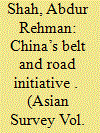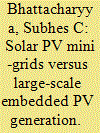| Srl | Item |
| 1 |
ID:
165943


|
|
|
|
|
| Summary/Abstract |
Following Sri Lanka, Pakistan is rapidly accumulating billions of dollars of Chinese debt under the Belt and Road Initiative. This paper argues that that initiative’s disregard for the economic viability of projects and the domestic limitations of countries like Sri Lanka and Pakistan have both external and internal ramifications for the recipient countries.
|
|
|
|
|
|
|
|
|
|
|
|
|
|
|
|
| 2 |
ID:
121194


|
|
|
|
|
| Publication |
2013.
|
| Summary/Abstract |
Sri Lanka's geographic positioning has been long recognized as an opportunity that requires strategic exploitation in pursuance of the development objectives of the country. Improving connectivity between India and Sri Lanka is perceived as a main avenue for exploiting this advantage. The re-establishment of the Indo-Lanka ferry operations, which discontinued 25 years ago owing to security concerns, is a step in this direction. This article presents the findings of a research to examine the viability of this ferry operation venture from a Sri Lankan viewpoint. It appraises comparative economics involved in long-distance ferry transportation of passengers between India and Sri Lanka. Possible demand scenarios are appraised based on the preference to shift modes expressed by aviation passengers. Viability is assessed according to selected service supply capacity options, fare levels and associated risks. Policies and strategies to improve the operational viability of the venture for a Sri Lankan investor are also discussed.
|
|
|
|
|
|
|
|
|
|
|
|
|
|
|
|
| 3 |
ID:
166365


|
|
|
|
|
| Summary/Abstract |
Despite significant grid expansion during the last decade, globally India has the highest number of people lacking access to electricity. Mini-grid has been suggested as a possible electrification option and the new mini-grid policy of the state of Uttar Pradesh has attracted global attention. Relatedly, the drive for grid extension restricts off-grid areas to very remote locations and enhances the risks for mini-grid projects. Simultaneously, the pledge for increasing renewable energy share in the power supply mix opens the possibility of large-scale embedded renewable energy generation in the rural areas. This paper investigates the viability of solar PV-based mini-grids using a discounted cash flow analysis and considers the UP-policy prescriptions to explore the case of a megawatt (MW)-scale grid-connected solar PV under a power purchase agreement. It identifies the viability support requirements for both cases under different business conditions. It finds that mini-grids are not a viable proposition if the tariff prescribed in UP is used and that other cost minimising support (such as capital subsidy or low interest debt or an output-based subsidy) would be required to attract private investments. Large-scale solar projects, on the other hand, are more viable and can be an attractive proposition for rural electrification in the Indian context.
|
|
|
|
|
|
|
|
|
|
|
|
|
|
|
|
| 4 |
ID:
147530


|
|
|
|
|
| Summary/Abstract |
Civil war peace agreements are prone to collapse. While some research suggests that multiple layers of power-sharing provisions lead to more viable agreements, others have suggested that negotiated settlements are not only more likely to return to violence, but that those cases will be more deadly as a result. We suggest here that previous research has failed to address the various ways that peace agreements emerge and that this context is crucial in explaining peace agreement viability. In some situations, rebels are likely to earn those concessions through battlefield success. Governments may feel compelled to address underlying grievances in order to stop the bloodshed and ultimately maintain some political clout in the postwar regime. In other cases, however, governments may feel pressure to engage in discussions and to provide concessions by outside actors, whether in the form of diplomatic intervention, economic, or foreign military intervention. Hypotheses are tested on all civil war peace agreements identified by the UCDP Peace Agreement Data-set for 1975–2011. Findings from logit and hazard models suggest that agreements brought about in the aftermath of military intervention on behalf of rebels are more likely to endure while those earned on the battlefield (i.e., stronger rebels) do not. In addition, mediation enhances peace agreement viability, while interventions on behalf of governments tend to undermine it.
|
|
|
|
|
|
|
|
|
|
|
|
|
|
|
|